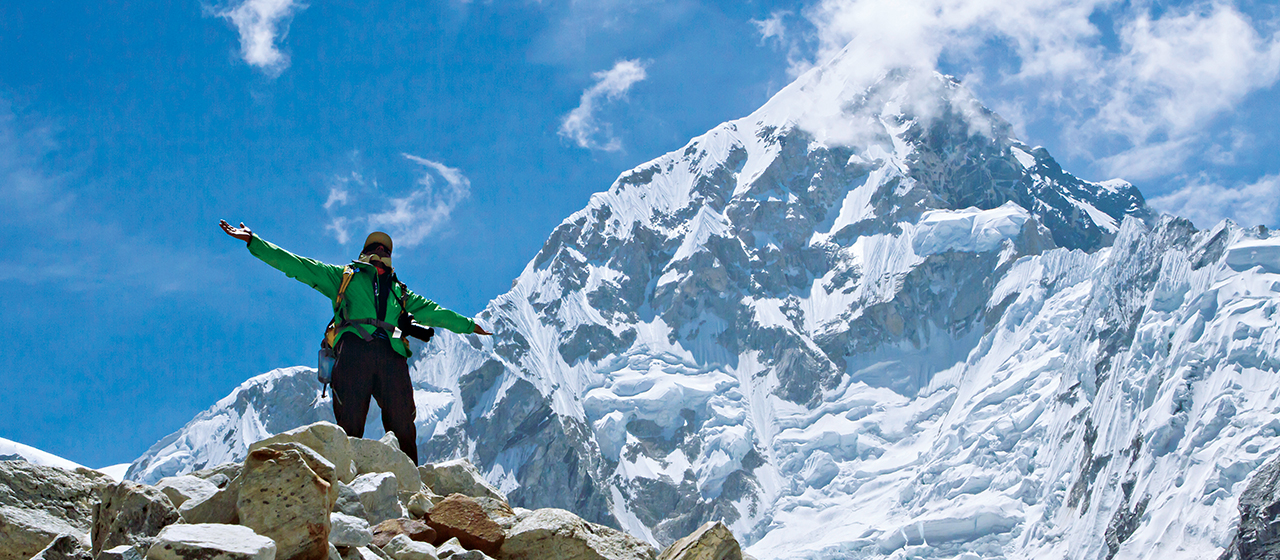The Everest Base Camp trek is one of the most popular trekking adventures in the world — and with good reason. But while the trek itself is filled with exhilarating physical challenges and jaw-droppingly beautiful scenery, trekking with Sherpas brings a special and intellectually rewarding dimension that goes beyond adventure. The indigenous people of the area, the Sherpas have lived in the shadow of Mount Everest for centuries, and their deep understanding of the mountains, customs, and way of life adds an invaluable layer to the trekking experience.
Sherpas are experienced guides who provide valuable insight on managing the troublesome terrain and keeping the climb as secure as possible. Long known for their expertise in the warm weather, altitude, and other hazards that may emerge on the trail, guides make sure trekkers can appreciate the majesty of the terrain while feeling secure knowing that they are in good hands. Acclimatization is more than just the lack of oxygen — Sherpas know how to gauge your body and the pace you need to take to endure the journey and avoid altitude sickness, pulling through the trekking experience as long as possible.
In addition to their expert guiding abilities, Sherpas offers trekkers a unique chance to experience the vibrant culture of the Everest area. As you walk along the trail, Sherpas offer insight into their spiritual beliefs steeped in the mountains they and many others hold sacred. They lead trekkers to sacred places, including monasteries and stupas, and describe the meaning behind Buddhist rituals, prayer flags, and the significance of the landscape. From their stories to their interactions, Sherpas provide insights into the lives of those who live and dwell in this magnificent land.
Trekking to Everest Base Camp with Sherpas is, in every sense of the word, an adventure, and also an unforgettable cultural experience—one that reminds you that every destination is also a doorway into the people, the land, and the culture that live and breathe there.
Read More Introduction to Everest Base Camp Trek
The Everest Base Camp Trek Reviews is one of the most popular trekking routes in the world, drawing trekkers from far and wide who want to explore the awe-inspiring Himalayas and immerse themselves in the lives of the Sherpa people. Located in Nepal’s Khumbu region, this trek leads trekkers to the base camp of the tallest mountain on earth, Mount Everest, which rises to 8,848 meters (29,029 feet). While this trek will not lead climbers to the summit of Everest, it will provide a fantastic experience as trekkers walk through serene Sherpa villages, lush forests, and improved rugged mountain terrains. It is a strenuous route that includes some steep ascents, high altitudes, and variable weather, but it can also be done by those with a moderate level of fitness. The trek usually starts with a flight to Lukla and a multi-day hike that passes sights like Namche Bazaar, Tengboche Monastery, and the Khumbu Icefall en route to base camp. During the journey, travelers experience interesting cultural processes, magnificent Himalayan views, and the daily lifestyle of the Sherpa people. The Everest Base Camp Trek is a once-in-a-lifetime journey for many, an amalgamation of physical challenge, cultural immersion, and incredible scenery.
Sherpa Guides on the Journey and Why They Matter
The Everest Base Camp Trek is an experience of a lifetime, and the Sherpa guides of the Khumbu region are instrumental in making it happen. The Sherpa people, who are native to the region of Khumbu, have evolved over time to be well-suited for a high-altitude lifestyle and have extensive knowledge of the mountains, climate, and culture. As seasoned guides and porters, Sherpas help trekkers traverse the treacherous trails, providing direction through rocky terrain, dense forest, and capricious weather. They know how to mitigate the risks of altitude sickness, which is a real threat in the high altitudes of Everest Base Camp, and they assist trekkers in acclimatizing properly by keeping the ascent gradual and taking rest days as needed. In addition to their technical skills, Sherpas enhance the trek experience by imparting cultural insights, traditions, and stories, allowing trekkers to experience life in the Everest region in an authentic way. Sherpas also play a vital role in keeping trekkers physically sound, helping with heavy lifting, and tending to injuries and other health concerns. Without their support and guidance, the trek would have been much harder, and not nearly as pleasurable. They offer vital insights that also transcend the physical, shedding light on a uniquely amazing journey.
Broad Information Regarding the Trekking Trail and Field
Everest Base Camp Trek Experience Renowned as an iconic journey, the Everest Base Camp Trek provides access to the splendor of the Khumbu region. The trek usually begins with a flight from Kathmandu to Lukla, a small mountain airport from where the adventure kicks off. Beginning in Lukla, the way is started through delightful Sherpa towns like Phakding, Namche Bazaar , and Tengboche, each giving a possibility to encounter neighborhood culture and cognizance. The landscape transforms dramatically as trekkers make their way through dense woods, cross suspension bridges, and climb rocky trails that provide stunning views of the peaks around them. The trail is quite steep in places, especially between the villages of Namche Bazaar and Tengboche, and the route involves walking on uneven ground and includes potential exposure to conditions at high altitudes. The landscape grows increasingly barren and rugged—glaciers, morain fields, rocky ridges—toward Everest Base Camp. The trek, physically hard, with elevation increases and changing conditions, demands that trekkers be ready for uncertain climates and tough terrain. The trek to Everest Base Camp is both strenuous and more of a voyage through variable and diverse scenery with unforgettable views of the top blankets on the planet.
A True Guide to Acclimatization through Sherpas for Altitude
Symptoms of high altitude can become problematic if not properly managed, so acclimatization is one of the most important factors you will need to consider when trekking to Everest Base Camp. Sherpas are instrumental in assisting trekkers to acclimatize and handle the impacts of altitude. They have a wealth of experience along with comprehensive knowledge of the region that assists trekkers in acclimatization to the varying altitudes slowly. Typical trekking itineraries will have acclimatization days at important points along the way like Namche Bazaar, Dingboche, and Tengboche, where trekkers rest and have their bodies adjust to the altitude. Sherpas keep an eye on trekkers’ health, looking for early signs of altitude sickness, including headaches, dizziness, and fatigue. They also help regulate the pace of the trek, so trekkers don’t ascend too rapidly and risk complications. As further backup, Sherpas are trained in high-altitude first aid, and can also provide immediate assistance if needed. Their advice and meticulous attention to acclimatization minimizes the dangers of high-altitude trekking. With the assistance of the Sherpas, trekkers can indeed make it to Everest Base Camp while coping with altitude and having a safe, memorable time overall.
Expedition: The Cultural Significance of Sherpas
Budget Everest Base Camp Trek While the Sherpas may be common guides and porters, they are an essential part of the cultural experience on the Everest Base Camp Trek. The Sherpa people have been living in the Khumbu region for generations, and their spirituality and culture are intertwined with the mountains. Sherpas consider the Himalayan mountains sacred, and their culture is steeped in Tibetan Buddhism, which permeates their daily lives, festivals, and rituals. During the trek, travelers will see elements of Sherpa culture, including trips to monasteries, stupas, and sacred sights, where they may witness Buddhist prayers and rituals. Sherpas themselves play a major role in the preservation and sharing of these cultural traditions, frequently serving as guides for trekkers through religious sites and relaying stories about the region and its spiritual significance. Sherpas have a reputation for their warm hospitality, and their strong sense of place shows in the way they take care of you. This will allow them to get to know more of the local culture and way of life that goes far beyond the physical challenge of trekking. The Sherpas do not only act as a guide or porter – they are the cultural caretakers of the Everest region, presenting trekkers with a fulfilling experience where adventure meets cultural insight.
Sherpas and the Role They Play in Safety and Navigation
Sherpas serve the purpose of making the route of Everest Base Camp more manageable and safe for trekkers. Sherpas are local people who know the area intimately and are familiar with the harsh conditions expected in the Everest region. They know the trekking route very well and can keep trekkers on the right track and safe from possible dangers like landslides, avalanches, or getting lost in the wild. My Sherpa ensures I’m safe on the trek helping me acclimatize to the high altitude, and replace water lost to dehydration, an important reminder that prevents altitude sickness. If all goes as planned, Sherpas also keep a close eye on trekkers for any signs of health-related issues, apply first aid when needed, and address other physical discomfort or injury. Their experience enables quick decision-making when the weather changes, for example, to finding shelter or adjusting the trekking pace to limit prolonged exposure to unfavorable weather. Many sherpas also help with specific sections of the trail that may be tricky, such as narrow ridges, steep inclines, and suspension bridges, so trekkers pass through those sections safely. Their knowledge of all things regarding safety, navigation, and altitude make the Sherpas an indispensable part of anyone’s Everest Base Camp trek when taking safety and success into account.
Holy Places and the Wayside Monasteries
Guided Everest Base Camp Trek As well as being a physical challenge, the trek to Everest Base Camp is a deeply spiritual one, taking in countless sacred sites and monasteries that hold enormous significance to the Sherpa people. These places hold great significance from religious and cultural aspects, allowing trekkers to gain some insight into the spiritual roots of the Himalayas. Along the way you will pass centuries-old monasteries, including Tengboche Monastery, located high up on a ridge, sharing stunning panoramas of Everest and surrounding peaks. This monastery, among the most venerated in the Khumbu region, serves as a point of focus for Buddhist rituals, as well as a moment of reflection and hushed contemplation for trekkers.
At these spiritual places, Sherpa guides frequently tell the stories of their ancestry, spiritual beliefs, and the rituals practiced by the local people — what is the significance of prayer flags, mani stones, and the tradition of offerings to the mountain gods. As visitors, you can hear monks praying, the blare of ceremonial horns, and an overwhelming – even mystical – sense of connection to a people and a land. These sacred sites are not only cultural beacons but spiritual markers that enrich the trekker’s adventure, providing moments of connection and reflection in one of Earth’s most magnificent landscapes.
Having Reverse but more powerful Inner Climb Nature, until the Soul reaches the Peak.
Luxury Everest Base Camp Trek Much more than a world-famous mountain, Mount Everest, or Sagarmatha in Nepal and Chomolungma in Tibet, is an incredibly sacred mountain to the people of the Khumbu area. To Sherpas and many other local communities, Everest is a holy mountain, considered the abode of gods and spirits. These divine forces that govern the region, find the mountain a guardian, protector, of serving such purpose. Sherpas believe in a rich Buddhist cosmology that views the mountain and surrounding landscape as sacred.
As trekkers head toward Everest Base Camp, Sherpas often describe their spiritual connection to the mountain, explaining rituals like the placement of prayer flags and the use of the mani stone — carved with mantras and prayers — to call blessings for a safe journey. The summit of Everest is indeed a potent spiritual destination in and of itself, and many believe that the balance between nature and humanity is out of whack with so many people clamoring up the mountain. Trekkers will encounter stupas and other sacred landmarks along the trail where locals will stop to offer prayers and perform ceremonies as a sign of respect for the mountain’s spiritual significance.
For trekkers, the understanding of Everest’s reverence adds to the experience, transforming the trek from a physical endeavor to a journey grounded in cultural roots. This spiritual aspect is what makes the Everest Base Camp trek way more than only the achievement of a goal, but a deep respect for the divinity that links man, land, and the gods who watch over it.
Advantages of Trekking with a Sherpa Guide
Exploring Everest Base Camp Trek while trekking is one of the exceptional experiences but it requires expert hands to guide through rugged terrain and high altitude. Here are some of the benefits of trekking with a Sherpa guide. Except for Sherpas, who are skilled mountaineers are actually an essential part of the trek, because no one knows the route and weather conditions better than them, and as well as have unprecedented degrees of high-altitude rehabilitation. Their presence allows trekkers to appreciate the adventure free from the overwhelming headaches of logistics and worries about safety.
Sherpas are cultural ambassadors, sharing their rich culture, heritage, and traditions along the way. They shed light on the Buddhist faith, rituals, and customs of the Sherpa population, giving trekkers an opportunity to engage with the land in a more profound way. Sherpas also know the nuances of the territory; they know when to hold back a group or tweak a route for the best experience, ensuring trekkers stay safe while making the journey more pleasurable. Their deep ties to the region guarantee that trekkers not only reach Everest Base Camp but also the cultural and spiritual richness of the journey.
In addition, Sherpas are trained to handle emergencies, whether it’s negotiating tricky terrain or assisting with altitude sickness. Their presence is priceless as they ensure that the trek remains safe and enriching; trekkers would certainly have peace of mind knowing that they are in capable hands.
The Difficulties of the Trek and Sherpa Assistance
Hoping to reach Everest Base Camp is a trip that comes with its own set of mental and physical challenges due to the high altitude, volatile weather, and rough terrain in the space. Steep ascents, rocky paths, and icy-cold rivers combine with rapidly changing weather conditions to make the trek difficult. With wool socks stuffed into hiking boots, trekkers pick through mud and rocks, slightly hunched as they ascend quickly to the high-altitude terrain where oxygen is far thinner than they are used to — and where their health and well-being will be at risk.
Everest Base Camp Trek Adventure Sherpas are key to climbers overcoming these challenges. With many years of experience in the high Himalayas, they know well about the risks of altitude sickness and gradual acclimatization. They settle the pace for the group, letting trekkers take stabs at rest at altitude to let their bodies acclimatize for the thinner air. They also know the land through which they move, helping trekkers avoid dangerous areas and traverse tricky parts of the trail safely.
The physical aspect of the hike has its difficulties but so does the mental fortitude needed to the complete trek, especially when fatigue sets in or camp is particularly challenging. Sherpas are there to give emotional and motivational support, spurring trekkers on and moving their focus to the end goal. From lending words of encouragement to sharing tales of previous treks, Sherpas make an irreplaceable contribution to the experience, helping benefit all trekkers not only safety-wise but also putting a bit of fun into anyone’s expedition. They are not just guides; they are the essential elements of the journey, as they help trekkers face challenges with courage and come out stronger.
Sherpas to the Rescue: Safety and Altitude Management
Now trekking to Everest Base Camp is already one of the most epic experiences in the world, but high-altitude trekking can be dangerous and safety and altitude management are vital! The Everest region is characterized by high altitude, fast-changing weather and rugged terrain, challenges for trekkers. That’s where the knowledge of a Sherpa guide comes in handy. Sherpas are trained to deal with any and all altitude-related issues, keeping trekkers safe the entire journey. With their knowledge of the terrain and deep understanding of high-altitude physiology, they closely monitor the health of the group and adjust the pace of the trek to reduce the risk of altitude sickness.
Solo Everest Base Camp Trek Sherpas knows how vital acclimatization is in the fight against altitude sickness. They help trekkers know when to take proper rest days, helping to allow bodies to acclimatize to the thinning air at higher altitudes. They also know how to spot the signs of altitude sickness in their trekkers and can act quickly should it be necessary, whether by altering the route, lowering the altitude, or obtaining medical assistance. Sherpas are trained in first aid and can save your life until medical help can reach you during an emergency.
Having Sherpas at your side also allows trekkers to take solace in the fact that their experience is being prioritized and their well-being is being considered.NOTE: Do not write an answer based on the above template Having them around is reassuring as they help to manage altitude in the physical sense, but the emotional and psychological security of having them with you to make sure that you are safe lets trekkers focus on the experience without fear of the journey ahead.
Final Thoughts: A True Balance of Adventure and Culture
The trek to Everest Base Camp is an experience that combines both adventures, in a physical sense, as well as a cultural one, as trekkers encounter some of the most beautiful scenery and breathtaking landscapes on the planet alongside insight into the traditions and spiritual significance of the region. The trek itself is no walk in the park, with its high-altitude ascents, rugged terrain, and unpredictable weather, but trekking with a Sherpa guide turns that experience into something experientially deeper and more rewarding. We know that Sherpas have unrivaled expertise that goes beyond simply traversing harrowing landscapes, not least of which is understanding how to keep trekkers healthy and safe, particularly in the event of altitude sickness.
But trekking alongside a Sherpa is about more than just their capacity to guide you. One of the main considerations for most trekkers is to learn about the local culture, Sherpas share more insights through spirituality, traditions, livelihood, and unique things about the localities. The journey becomes a journey not only to the mountain — it’s also a way to connect and understand the traditional way of living of the Sherpa people, and the sanctity of the mountains they inhabit.
Combining the support and guidance of a Sherpa, trekkers are able to challenge themselves physically through the trek, gaining a more authentic and nuanced connection to the land and its people. The Everest Base Camp trek is among the most rewarding sublime adventures on earth part culture shock, part social adventure.






Leave a Reply